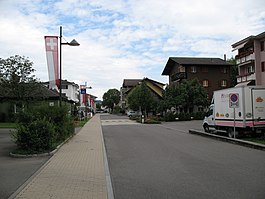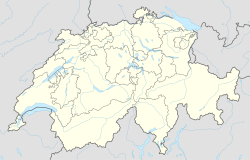Stansstad
Stansstad | |
|---|---|
 | |
| Coordinates: 46°58.602′N 8°20.403′E / 46.976700°N 8.340050°E | |
| Country | Switzerland |
| Canton | Nidwalden |
| District | n.a. |
| Area | |
| • Total | 17.11 km2 (6.61 sq mi) |
| Elevation | 436 m (1,430 ft) |
| Population (Dec 2015) | |
| • Total | 4,396 |
| • Density | 260/km2 (670/sq mi) |
| Time zone | UTC+01:00 (Central European Time) |
| • Summer (DST) | UTC+02:00 (Central European Summer Time) |
| Postal code(s) | 6362 |
| SFOS number | 1510 |
| ISO 3166 code | CH-NW |
| Surrounded by | Alpnach (OW), Ennetbürgen, Ennetmoos, Hergiswil, Horw (LU), Meggen (LU), Stans, Weggis (LU) |
| Website | www SFSO statistics |
Stansstad is a municipality in the canton of Nidwalden in Switzerland.
Geography


Stansstad has an area, (as of the 2004/09 survey) of 9.07 km2 (3.50 sq mi).[1] Of this area, about 32.6% is used for agricultural purposes, while 49.6% is forested. Of the rest of the land, 15.4% is settled (buildings or roads) and 2.4% is unproductive land. In the 2004/09 survey a total of 80 ha (200 acres) or about 8.8% of the total area was covered with buildings, an increase of 15 ha (37 acres) over the 1981/82 amount. Over the same time period, the amount of recreational space in the municipality increased by 1 ha (2.5 acres) and is now about 0.99% of the total area. Of the agricultural land, 10 ha (25 acres) is used for orchards and vineyards and 307 ha (760 acres) is fields and grasslands. Since 1981/82 the amount of agricultural land has decreased by 24 ha (59 acres). Rivers and lakes cover 9 ha (22 acres) in the municipality.[2][3]
Demographics
Stansstad has a population (as of December 2020[update]) of 4,727.[4] As of 2014[update], 15.2% of the population are resident foreign nationals. In 2015 a small minority (234 or 5.3% of the population) was born in Germany.[5] Over the last 4 years (2010-2014) the population has changed at a rate of -1.44%. The birth rate in the municipality, in 2014, was 9.1, while the death rate was 8.0 per thousand residents.[3]
As of 2014[update], children and teenagers (0–19 years old) make up 14.1% of the population, while adults (20–64 years old) are 63.3% and seniors (over 64 years old) make up 22.6%.[3] In 2015 there were 1,800 single residents, 1,950 people who were married or in a civil partnership, 222 widows or widowers and 424 divorced residents.[6]
In 2014 there were 2,131 private households in Stansstad with an average household size of 2.03 persons. Of the 629 inhabited buildings in the municipality, in 2000, about 34.5% were single family homes and 39.6% were multiple family buildings. Additionally, about 13.7% of the buildings were built before 1919, while 14.8% were built between 1991 and 2000.[7] In 2013 the rate of construction of new housing units per 1000 residents was 1.36. The vacancy rate for the municipality, in 2015[update], was 2.7%.[3]
Most of the population (as of 2000[update]) speaks German (90.1%), with Italian being second most common (2.1%) and Albanian being third (1.5%).[8]
Historical population
The historical population is given in the following chart:[9] <timeline> Colors=
id:lightgrey value:gray(0.9) id:darkgrey value:gray(0.8)
ImageSize = width: auto height:200 barincrement:45 PlotArea = top:20 left:40 bottom:20 right:35 AlignBars = justify DateFormat = x.y Period = from:0 till:5000 TimeAxis = orientation:vertical AlignBars = justify ScaleMajor = gridcolor:darkgrey increment:1000 start:0 ScaleMinor = gridcolor:lightgrey increment:250 start:0 PlotData=
color:yellowgreen width: 35 mark:(line,white) align:center bar:1850 from:start till:778 text:"778" bar:1860 from:start till:752 text:"752" bar:1870 from:start till:755 text:"755" bar:1880 from:start till:760 text:"760" bar:1888 from:start till:836 text:"836" bar:1900 from:start till:851 text:"851" bar:1910 from:start till:925 text:"925" bar:1920 from:start till:859 text:"859" bar:1930 from:start till:1032 text:"1,032" bar:1941 from:start till:1174 text:"1,174" bar:1950 from:start till:1318 text:"1,318" bar:1960 from:start till:1738 text:"1,738" bar:1970 from:start till:2469 text:"2,469" bar:1980 from:start till:3104 text:"3,104" bar:1990 from:start till:3785 text:"3,785" bar:2000 from:start till:4325 text:"4,325" bar:2010 from:start till:4440 text:"4,440" bar:2014 from:start till:4381 text:"4,381"
</timeline>
Politics
In the 2015 federal election the most popular party was the SVP with 83.8% of the vote, followed by local parties with the remaining 16.2%. In the federal election, a total of 1,805 votes were cast, and the voter turnout was 55.0%.[10]
In the 2007 federal election the most popular party was the FDP which received 88.6% of the vote. Most of the rest of the votes were given to local, small right-wing parties (10.8%).[8]
Education
In Stansstad about 77.9% of the population (between age 25–64) have completed either non-mandatory upper secondary education or additional higher education (either university or a Fachhochschule).[8]
Economy
Stansstad is a high-income community. The municipality is part of the regional center of Stans.[11]
As of 2014[update], there were a total of 2,163 people employed in the municipality. Of these, a total of 74 people worked in 26 businesses in the primary economic sector. The secondary sector employed 525 workers in 63 separate businesses. A minority (26.1%) of the secondary sector employees worked in very small businesses. There were 10 small businesses with a total of 198 employees and two mid sized businesses with a total of 190 employees. Finally, the tertiary sector provided 1,564 jobs in 355 businesses. There were 20 small businesses with a total of 495 employees and two mid sized businesses with a total of 222 employees.[12]
In 2014 a total of 1.4% of the population received social assistance.[3]
In 2015 local hotels had a total of 19,501 overnight stays, of which 51.8% were international visitors.[13]
Transport
Stansstad is served by Stansstad station on the Luzern–Stans–Engelberg line, on which the Lucerne S-Bahn S4 service provides two trains per hour. The village is also served by post bus services, including services to Bürgenstock, Stans and Büren, and by shipping services of the Schifffahrtsgesellschaft des Vierwaldstättersees on Lake Lucerne.[14][15][16][17]
Fürigenbahn was a funicular that led from Harissenbucht to the hotel at Fürigen (1924-2005).
Sights

The main sights of Stansstad are a museum of the fortifications, a tower (Schnitzturm), and the chapel Marie Linden in Kehrsiten.
Heritage sites of national significance
The prehistoric lakeside settlement at Kehrsiten and the Teller/Palisaden and Schnitzturm, all part of the medieval fortifications are listed as Swiss heritage site of national significance.[18] The prehistoric settlement is part of the Prehistoric Pile dwellings around the Alps a UNESCO World Heritage Site.[19]
References
- ^ Arealstatistik Standard - Gemeindedaten nach 4 Hauptbereichen
- ^ "Arealstatistik Land Use - Gemeinden nach 10 Klassen". www.landuse-stat.admin.ch. Swiss Federal Statistical Office. 24 November 2016. Retrieved 27 December 2016.
- ^ 3.0 3.1 3.2 3.3 3.4 Swiss Federal Statistical Office - Regional portraits accessed 27 October 2016
- ^ "Ständige und nichtständige Wohnbevölkerung nach institutionellen Gliederungen, Geburtsort und Staatsangehörigkeit". bfs.admin.ch (in Deutsch). Swiss Federal Statistical Office - STAT-TAB. 31 December 2020. Retrieved 21 September 2021.
- ^ Federal Statistical Office - Ständige und nichtständige Wohnbevölkerung nach institutionellen Gliederungen, Geburtsort und Staatsangehörigkeit (Land) accessed 31 October 2016
- ^ Swiss Federal Statistical Office - Ständige und nichtständige Wohnbevölkerung nach institutionellen Gliederungen, Geschlecht, Zivilstand und Geburtsort (in German) accessed 8 September 2016
- ^ Swiss Federal Statistical Office STAT-TAB - Thema 09 - Bau- und Wohnungswesen (in German) accessed 5 May 2016
- ^ 8.0 8.1 8.2 Swiss Federal Statistical Office accessed 04-Sep-2009
- ^ Swiss Federal Statistical Office STAT-TAB Bevölkerungsentwicklung nach institutionellen Gliederungen, 1850-2000 (in German) accessed 27 April 2016
- ^ Swiss Federal Statistical Office - Nationalratswahlen 2015: Stärke der Parteien und Wahlbeteiligung nach Gemeinden Archived 2016-08-02 at the Wayback Machine (in German) accessed 18 July 2016
- ^ "Die Raumgliederungen der Schweiz 2016" (in Deutsch, français, italiano, and English). Neuchâtel, Switzerland: Swiss Federal Statistical Office. 17 February 2016. Retrieved 14 December 2016.
- ^ Federal Statistical Office -Arbeitsstätten und Beschäftigte nach Gemeinde, Wirtschaftssektor und Grössenklasse accessed 31 October 2016
- ^ Federal Statistical Office - Hotellerie: Ankünfte und Logiernächte der geöffneten Betriebe accessed 31 October 2016
- ^ "Luzern–Alpnachstad (Vierwaldstättersee)" (PDF). Bundesamt für Verkehr. Retrieved 2013-01-07.
- ^ "Luzern–Stans–Engelberg" (PDF). Bundesamt für Verkehr. Retrieved 2013-01-14.
- ^ "Stansstad–Obbürgen–Bürgenstock (Linie 321)" (PDF). Bundesamt für Verkehr. Retrieved 2013-01-18.
- ^ "BürenNW–Oberdorf NW–Stans–Stansstad (Linie 323)" (PDF). Bundesamt für Verkehr. Retrieved 2013-01-18.
- ^ "KGS-Inventar". KGS Inventar (in German). Federal Office of Civil Protection. 2009. Archived from the original on 28 June 2010. Retrieved 12 July 2010.
{{cite web}}: CS1 maint: unrecognized language (link) - ^ UNESCO World Heritage Site - Prehistoric Pile dwellings around the Alps
- CS1 Deutsch-language sources (de)
- Articles with German-language sources (de)
- Webarchive template wayback links
- CS1 français-language sources (fr)
- CS1 italiano-language sources (it)
- CS1 maint: unrecognized language
- Short description with empty Wikidata description
- Coordinates not on Wikidata
- All articles containing potentially dated statements
- Articles containing potentially dated statements from 2014
- Articles with invalid date parameter in template
- Articles containing potentially dated statements from 2015
- Commons category link is defined as the pagename
- Stansstad
- Municipalities of Nidwalden
- Populated places on Lake Lucerne


